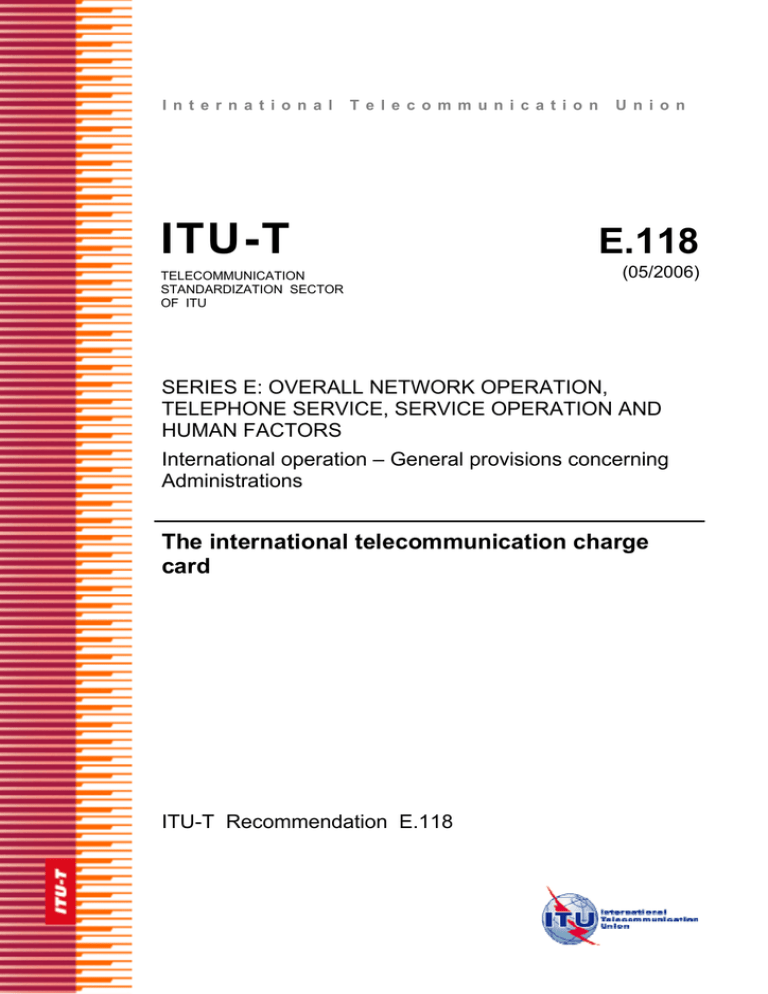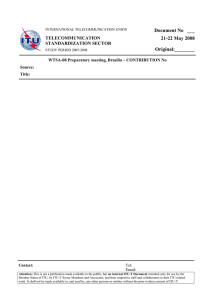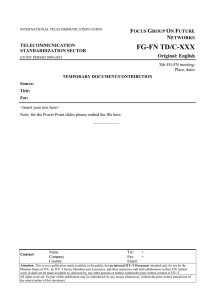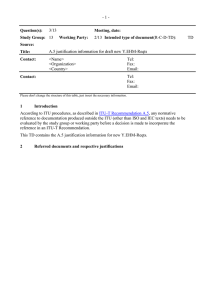
I n t e r n a t i o n a l
T e l e c o m m u n i c a t i o n
ITU-T
TELECOMMUNICATION
STANDARDIZATION SECTOR
OF ITU
U n i o n
E.118
(05/2006)
SERIES E: OVERALL NETWORK OPERATION,
TELEPHONE SERVICE, SERVICE OPERATION AND
HUMAN FACTORS
International operation – General provisions concerning
Administrations
The international telecommunication charge
card
ITU-T Recommendation E.118
ITU-T E-SERIES RECOMMENDATIONS
OVERALL NETWORK OPERATION, TELEPHONE SERVICE, SERVICE OPERATION AND HUMAN
FACTORS
INTERNATIONAL OPERATION
Definitions
General provisions concerning Administrations
General provisions concerning users
Operation of international telephone services
Numbering plan of the international telephone service
International routing plan
Tones in national signalling systems
Numbering plan of the international telephone service
Maritime mobile service and public land mobile service
OPERATIONAL PROVISIONS RELATING TO CHARGING AND ACCOUNTING IN THE
INTERNATIONAL TELEPHONE SERVICE
Charging in the international telephone service
Measuring and recording call durations for accounting purposes
UTILIZATION OF THE INTERNATIONAL TELEPHONE NETWORK FOR NONTELEPHONY APPLICATIONS
General
Phototelegraphy
ISDN PROVISIONS CONCERNING USERS
INTERNATIONAL ROUTING PLAN
NETWORK MANAGEMENT
International service statistics
International network management
Checking the quality of the international telephone service
TRAFFIC ENGINEERING
Measurement and recording of traffic
Forecasting of traffic
Determination of the number of circuits in manual operation
Determination of the number of circuits in automatic and semi-automatic operation
Grade of service
Definitions
Traffic engineering for IP-networks
ISDN traffic engineering
Mobile network traffic engineering
QUALITY OF TELECOMMUNICATION SERVICES: CONCEPTS, MODELS, OBJECTIVES
AND DEPENDABILITY PLANNING
Terms and definitions related to the quality of telecommunication services
Models for telecommunication services
Objectives for quality of service and related concepts of telecommunication services
Use of quality of service objectives for planning of telecommunication networks
Field data collection and evaluation on the performance of equipment, networks and services
OTHER
For further details, please refer to the list of ITU-T Recommendations.
E.100–E.103
E.104–E.119
E.120–E.139
E.140–E.159
E.160–E.169
E.170–E.179
E.180–E.189
E.190–E.199
E.200–E.229
E.230–E.249
E.260–E.269
E.300–E.319
E.320–E.329
E.330–E.349
E.350–E.399
E.400–E.404
E.405–E.419
E.420–E.489
E.490–E.505
E.506–E.509
E.510–E.519
E.520–E.539
E.540–E.599
E.600–E.649
E.650–E.699
E.700–E.749
E.750–E.799
E.800–E.809
E.810–E.844
E.845–E.859
E.860–E.879
E.880–E.899
E.900–E.999
ITU-T Recommendation E.118
The international telecommunication charge card
Summary
Telecommunication charge cards may be issued by Operating Agencies (OAs) to allow customers to
use their card in connection with various international services at appropriate charges for each
transaction and have the charges billed to their account in the country where the OA issued the
charge card. Cards issued by OAs in accordance with this Recommendation conform to the
appropriate ISO standards.
This Recommendation has been revised to allow alternative, application-specific standards for
IC cards where unique form factors require such alternatives.
Source
ITU-T Recommendation E.118 was approved on 11 May 2006 by ITU-T Study Group 2
(2005-2008) under the Resolution 1 approval process.
History
1.0
E.118
1988-11-25
2.0
E.118
1992-08-04
3.0
E.118
1996-07-19
4.0
E.118
2001-02-02
5.0
E.118
2006-05-11
ITU-T Rec. E.118 (05/2006)
i
FOREWORD
The International Telecommunication Union (ITU) is the United Nations specialized agency in the field of
telecommunications. The ITU Telecommunication Standardization Sector (ITU-T) is a permanent organ of
ITU. ITU-T is responsible for studying technical, operating and tariff questions and issuing
Recommendations on them with a view to standardizing telecommunications on a worldwide basis.
The World Telecommunication Standardization Assembly (WTSA), which meets every four years,
establishes the topics for study by the ITU-T study groups which, in turn, produce Recommendations on
these topics.
The approval of ITU-T Recommendations is covered by the procedure laid down in WTSA Resolution 1.
In some areas of information technology which fall within ITU-T's purview, the necessary standards are
prepared on a collaborative basis with ISO and IEC.
NOTE
In this Recommendation, the expression "Administration" is used for conciseness to indicate both a
telecommunication administration and a recognized operating agency.
Compliance with this Recommendation is voluntary. However, the Recommendation may contain certain
mandatory provisions (to ensure e.g. interoperability or applicability) and compliance with the
Recommendation is achieved when all of these mandatory provisions are met. The words "shall" or some
other obligatory language such as "must" and the negative equivalents are used to express requirements. The
use of such words does not suggest that compliance with the Recommendation is required of any party.
INTELLECTUAL PROPERTY RIGHTS
ITU draws attention to the possibility that the practice or implementation of this Recommendation may
involve the use of a claimed Intellectual Property Right. ITU takes no position concerning the evidence,
validity or applicability of claimed Intellectual Property Rights, whether asserted by ITU members or others
outside of the Recommendation development process.
As of the date of approval of this Recommendation, ITU had not received notice of intellectual property,
protected by patents, which may be required to implement this Recommendation. However, implementors
are cautioned that this may not represent the latest information and are therefore strongly urged to consult the
TSB patent database.
ITU 2006
All rights reserved. No part of this publication may be reproduced, by any means whatsoever, without the
prior written permission of ITU.
ii
ITU-T Rec. E.118 (05/2006)
CONTENTS
Page
1
Scope ............................................................................................................................
1
2
References.....................................................................................................................
1
3
Abbreviations................................................................................................................
1
4
Numbering system ........................................................................................................
4.1
Card numbering structure ...............................................................................
4.2
Issuer identifier number assignment and registration procedure....................
4.3
Information content ........................................................................................
1
1
2
5
5
Printed cards .................................................................................................................
5
6
Magnetic stripe cards....................................................................................................
6.1
Encoding requirements...................................................................................
6.2
Expiration date................................................................................................
6.3
Service code....................................................................................................
6.4
Discretionary data...........................................................................................
5
5
6
6
6
7
Integrated Circuit (IC) cards.........................................................................................
6
Annex A – Service code assignments ......................................................................................
7
Appendix I – Implementation guidelines for the assignment of issuer identifier numbers .....
8
ITU-T Rec. E.118 (05/2006)
iii
ITU-T Recommendation E.118
The international telecommunication charge card
1
Scope
Telecommunication charge cards may be issued by Operating Agencies (OAs) to allow customers
to use their card in connection with various international services at appropriate charges for each
transaction and have the charges billed to their account in the country where the OA issued the
charge card. Cards issued by OAs in accordance with this Recommendation conform to the
appropriate ISO Standards.
2
References
The following ITU-T Recommendations and other references contain provisions which, through
reference in this text, constitute provisions of this Recommendation. At the time of publication, the
editions indicated were valid. All Recommendations and other references are subject to revision;
users of this Recommendation are therefore encouraged to investigate the possibility of applying the
most recent edition of the Recommendations and other references listed below. A list of the
currently valid ITU-T Recommendations is regularly published. The reference to a document within
this Recommendation does not give it, as a stand-alone document, the status of a Recommendation.
[1]
ISO/IEC 7812-1:2000, Identification cards – Identification of issuers – Part 1: Numbering
system.
[2]
ITU-T Recommendation E.164 (2005), The international public telecommunication
numbering plan.
[3]
ISO/IEC 7812-2:2000, Identification cards – Identification of issuers – Part 2: Application
and registration procedures.
3
Abbreviations
This Recommendation uses the following abbreviations:
IC
Integrated Circuit
IIN
Issuer Identifier Number
MII
Major Industry Identifier
4
Numbering system
4.1
Card numbering structure
The numbering of the card to be issued by OAs shall be as follows based on ISO/IEC 7812-1 [1]
(Identification cards – Identification of issuers – Part 1: Numbering system) and
ISO/IEC 7812-2 [3] (Identification cards – Identification of issuers – Part 2: Application and
registration procedures).
ITU-T Rec. E.118 (05/2006)
1
The maximum length of the visible card number (primary account number) shall be 19 characters
and is composed of the following subparts (see Figure 1):
–
Major Industry Identifier (MII);
–
country code;
–
issuer identifier;
–
individual account identification number;
–
parity check digit computed according to the Luhn formula (see ISO/IEC 7812-1, Annex B
[1]). In addition to the parity check digit, OAs may incorporate a validation check device in
some location on the card which could be changed when new cards are issued.
NOTE – Major industry and issuer identifier numbers of the form 66xxxx have already been assigned to
some Administrations as a transitional measure. Charge cards of this type are fully compatible with
ISO Standards.
Figure 1/E.118 – Charge card numbering system
4.2
a)
b)
c)
2
Issuer identifier number assignment and registration procedure
The assignment of specific issuer identifier numbers should be the responsibility of a
country or group of countries as appropriate. These numbers should only be assigned to
OAs with the agreement of their Administrations.
These issuer identifier numbers are normally used to distinguish among multiple OAs who
issue cards within a country. However, these numbers may also be used to distinguish
individual countries sharing the same country code (as defined in ITU-T Rec. E.164 [2]) or,
if appropriate, to distinguish both countries and issuers.
The Director of TSB is responsible for the registration and/or cancellation of issuer
identifier numbers (IINs) for OAs with the approval of their Administrations. An
illustrative registration form is contained in Figure 2.
ITU-T Rec. E.118 (05/2006)
d)
e)
f)
g)
h)
A one-time fee shall be collected in order for an IIN to be assigned and registered by TSB.
Applications shall be accompanied by evidence of payment to ITU of the one-time fee.
In the event of technical or operational difficulties in allocating an IIN, the Director of TSB
should consult the Chairman of Study Group 2.
The TSB shall maintain a list of the allocated IINs.
Additions, deletions and changes to this list should be published in the first available
ITU Operational Bulletin.
The consolidated list of allocated IINs should be published periodically in the
ITU Operational Bulletin.
ITU-T Rec. E.118 (05/2006)
3
Registration form for a single Issuer Identifier Number for the international
telecommunication charge card
INTERNATIONAL TELECOMMUNICATION UNION
TELECOMMUNICATION STANDARDIZATION BUREAU
PLACE DES NATIONS, CH - 1211 GENEVE 20, SWITZERLAND
FAX: +41 22 730 5853
To be returned with registration fee to:
A.
TO BE COMPLETED BY APPLICANT (Card Issuer)
Name or organization
Address to be registered (maximum two lines, 30 characters per line)
Principal contact in organization
Telephone number
+
Address for correspondence
E-mail
Fax number
+
Effective date of usage or cancellation
Date
Signature
In signing this form, the applicant accepts that further IINs will not be assigned to identify products, services, technologies or
geographic locations.
B. TO BE COMPLETED AND APPROVED BY THE TELECOMMUNICATIONS ADMINISTRATIONa) OR DULY
AUTHORIZED COORDINATING ORGANIZATION
a)
Action requested (check appropriate box)
b)
Major industry identifier (MII): 89
c)
Country code (CC):
d)
Issuer identifier number: ___________________
___________________
Registration
or Cancellation
(according to the List, Complement to ITU-T Rec. E.164)
(according to ITU-T Rec. E.118)
Name of approving organization
Date
C.
Signature
TO BE COMPLETED BY ITU (CENTRAL REGISTRATION AUTHORITY)
Issuer Identification Number registered or cancelled
8
a)
Date:
9
and/or Operating Agency (OA).
METHOD OF PAYMENT
(Please specify the form of payment used)
Switzerland: to ITU's current postal account, Geneva 12-50-3;
All other countries: –
by international money order, or
–
by bank transfer to UBS SA, ITU Geneva, Geneva (Switzerland)
ITU Account No. 240-C8765565.0
(Payment may also be effected by a cheque made out in another currency freely convertible into Swiss francs, provided that the
cheque, when cashed and converted, will cover the amount of the registration fee in Swiss francs.)
By credit card
EUROCARD-MASTERCARD
Credit card number: _______________________________
Holder's name:
_______________________________
VISA
AMERICAN EXPRESS
Valid date: __________________________
Signature: __________________________
(This form must be signed if you pay by credit card.) Please note: Letters of credit are not accepted.
Figure 2/E.118 − Illustrative registration form
4
ITU-T Rec. E.118 (05/2006)
4.3
Information content
The information on an international telecommunication charge card shall clearly include:
1)
the card number (on a combined national/international card, the national number, if
different, should be appropriately designated);
and should optionally include:
2)
the name of the issuing OA1 and, where appropriate, the country of issue;
3)
the card holder's name and signature;
4)
the date of expiry, in the format of either "MM/YY" or "MM-YY";
5)
instructions on how the card should be used. (Some OAs may prefer to issue instructions
separately.)
In addition, the logo of the ITU may, at the card issuer's option, appear somewhere on the card to
facilitate recognition of the card by card acceptors where presentation of the card is required as a
part of the service (i.e., bureau services).
5
Printed cards
The charge card should be designed to be conveniently carried. Current ISO Standards define the
dimensions of financial transaction cards to be 85.60 mm × 53.98 mm (3.370 × 2.125 inches) and
the ITU-T considers that telephone charge cards issued by OAs should have similar dimensions.
6
Magnetic stripe cards
For maximum flexibility, convenience of use and economic benefits, the magnetic stripe cards to be
issued by OAs should conform to the relevant ISO Standards concerning materials, recording
techniques, physical dimensions and the type and format of embossed information.
These are:
ISO/IEC 7810:
Identification cards – Physical characteristics.
ISO/IEC 7811-1:
Identification cards – Recording technique – Part 1: Embossing.
ISO/IEC 7811-2:
Identification cards – Recording technique – Part 2: Magnetic stripe – Low
coercivity.
ISO/IEC 7811-6:
Identification cards – Recording technique – Part 6: Magnetic stripe – High
coercivity.
ISO/IEC 7813:
Identification cards – Financial transaction cards.
6.1
Encoding requirements
Track 2 of the magnetic stripe on the telecommunication charge card shall be used as a primary
means of communicating data encoded on the magnetic stripe. The Primary Account Number
(PAN) is the only field that is required to be encoded. An example of the encoding of this minimum
information is contained in Table 1.
____________________
1
Although optional, card issuer OAs are encouraged to include their name, where possible, to avoid
problems when the card is presented to an operator.
ITU-T Rec. E.118 (05/2006)
5
Table 1/E.118 − Minimum encoding requirements
STX
Start Sentinel
BCD 11
PAN
Primary Account Number
89...(e.g., 8912538360010000L)
FS
Field Separator
BCD 13
ED
Expiration Date
BCD 13
SC
Service Code
BCD 13
DD
Discretionary Data
null
ETX
End Sentinel
BCD 15
LRC
Longitudinal Redundancy Check
[1 digit]
Card issuers may, at their own discretion, encode data on track 2 of the telecommunication charge
card in addition to the required information. This data is defined below. An example of the
encoding of all such information (except discretionary data) is contained in Table 2.
Table 2/E.118 − Full encoding requirements
STX
Start Sentinel
BCD 11
PAN
Primary Account Number
89...(e.g., 9812538360010000L)
FS
Field Separator
BCD 13
ED
Expiration Date
YYMM (e.g., "9612" for December 1996)
SC
Service Code
XXX (e.g., "125" – International use, positive
authorization is mandatory, telecommunications
services only with a PIN being required)
DD
Discretionary Data
...
ETX
End Sentinel
BCD 15
LRC
Longitudinal Redundancy Check
[1 digit]
6.2
Expiration date
If the expiration date is embossed on the front of the telecommunication charge card, it should also
be encoded on track 2 of the magnetic stripe. The format is defined by ISO/IEC 7813 as YYMM.
The position of the expiration date is shown in Table 2 and is dependent on encoding requirements
and service agreements. If the expiration date is not embossed on the front of the card and it is not
encoded on the magnetic stripe, a field separator shall be encoded in its place (see Table 1).
6.3
Service code
OAs are encouraged to encode information within the service code field. If it is not encoded on the
magnetic stripe, a field separator shall be encoded in its place (see Table 1). There are three
positions to the service code field. The positions and the interpretation for each of the possible
values are contained in Annex A.
6.4
Discretionary data
Any information contained in the discretionary data field is for further study.
7
Integrated Circuit (IC) cards
The standard for the IC card is to be established by ISO/IEC JTC 1/SC 17. In addition, specific
applications (e.g., SIM cards in GSM applications and USIM cards in UMTS/IMT-2000
applications) may make use of alternative standards to address unique form factors of their
application.
6
ITU-T Rec. E.118 (05/2006)
Annex A
Service code assignments
Tables A.1 to A.3 describe the various values that may be used in each of the three positions of the
service code field. For each value, the second column of each table describes how the value is
interpreted specifically for cards defined by this Recommendation.
The first digit of the service code describes the type of interchange permissible for the card. The
second digit describes the level of authorization processing required to validate the card. For this
Recommendation, this value is only interpreted for card systems using fully automated validation
(see ITU-T Rec. E.113). The third digit describes the types of services allowable by the card holder.
Table A.1/E.118 − Permissible interchange values – Position 1
Values
Telecommunication usage
0
Not used
1
International use is permitted
2
International use is permitted for integrated circuit cards
3
Not used
4
Not used
5
Restricted to use on national networks only
6
Restricted to use on national networks only, for integrated circuit cards
7
Restricted for use only on the card issuer's network
8
Not used
9
Usable for test purposes only
Table A.2/E.118 − Level of authorization – Position 2
Values
Telecommunication usage
0
No specific authorization defined
1
Not used
2
Positive authorization is required when used in a full validation environment
3
Not used
4
Positive authorization is required when used in a full validation environment but
special backup arrangements are defined in the service agreement
5
Not used
6
Not used
7
Not used
8
Not used
9
Not used
ITU-T Rec. E.118 (05/2006)
7
Table A.3/E.118 − Service availability – Position 3
Values
Telecommunication usage
0
Card not restricted to telecommunication services; PIN required
1
Card not restricted to telecommunication services
2
Can be used to charge telecommunication services only
3
Not used within the scope of ITU-T Rec. E.116
4
Not used within the scope of ITU-T Rec. E.116
5
Can be used to charge telecommunication services only; PIN required
6
Not used
7
Not used
8
Not used
9
Not used
Appendix I
Implementation guidelines for the assignment of issuer identifier numbers
Card issuers will be assigned a single Issuer Identifier Number (IIN) from the ITU's block of
"89" IINs. To assist card issuers in effectively planning card services and the TSB in processing
applications, the following information may be helpful:
a)
Separate Issuer Identifier Numbers should not be used to differentiate between different
products or services for which the card may be used.
b)
Separate Issuer Identifier Numbers should not be used to differentiate between technologies
implemented in the card (e.g., magnetic stripe versus integrated circuit cards) or for
products and services based on or implemented using different technologies (e.g., IP-based
voice services versus circuit switched voice services).
c)
Separate Issuer Identifier Numbers should not be used to differentiate between different
branches or subsidiaries of the same corporation. However, situations where card issuers
operating in different countries or regulatory environments where different accounting or
settlement rates exist, the assignment of additional IINs to a specific card issuer may be
justified.
If card issuers need to make such differentiation, different values within the leading digits of the
Individual Account Identification should be used.
8
ITU-T Rec. E.118 (05/2006)
SERIES OF ITU-T RECOMMENDATIONS
Series A
Organization of the work of ITU-T
Series D
General tariff principles
Series E
Overall network operation, telephone service, service operation and human factors
Series F
Non-telephone telecommunication services
Series G
Transmission systems and media, digital systems and networks
Series H
Audiovisual and multimedia systems
Series I
Integrated services digital network
Series J
Cable networks and transmission of television, sound programme and other multimedia signals
Series K
Protection against interference
Series L
Construction, installation and protection of cables and other elements of outside plant
Series M
Telecommunication management, including TMN and network maintenance
Series N
Maintenance: international sound programme and television transmission circuits
Series O
Specifications of measuring equipment
Series P
Telephone transmission quality, telephone installations, local line networks
Series Q
Switching and signalling
Series R
Telegraph transmission
Series S
Telegraph services terminal equipment
Series T
Terminals for telematic services
Series U
Telegraph switching
Series V
Data communication over the telephone network
Series X
Data networks, open system communications and security
Series Y
Global information infrastructure, Internet protocol aspects and next-generation networks
Series Z
Languages and general software aspects for telecommunication systems
Printed in Switzerland
Geneva, 2006




